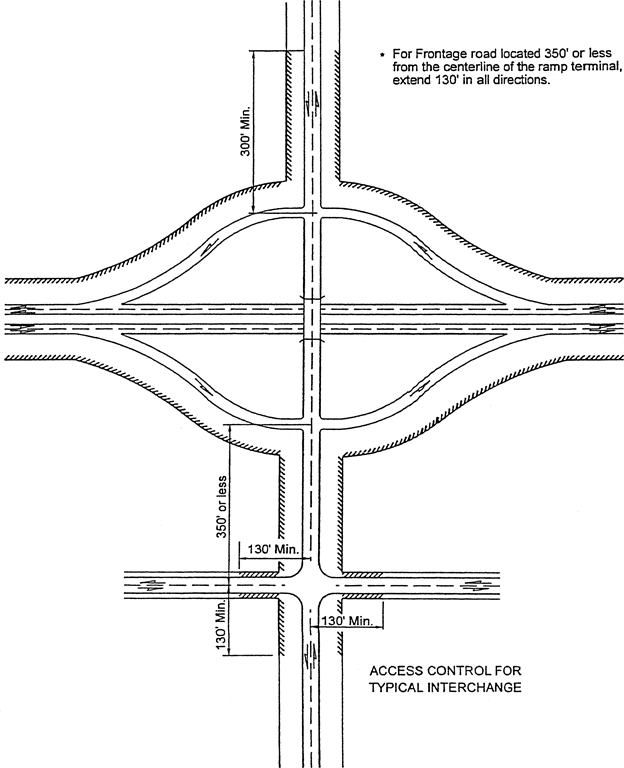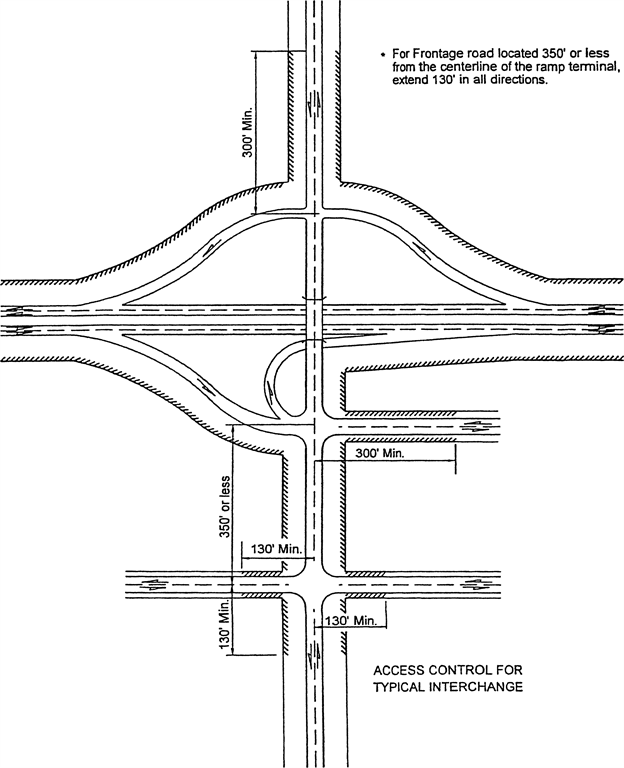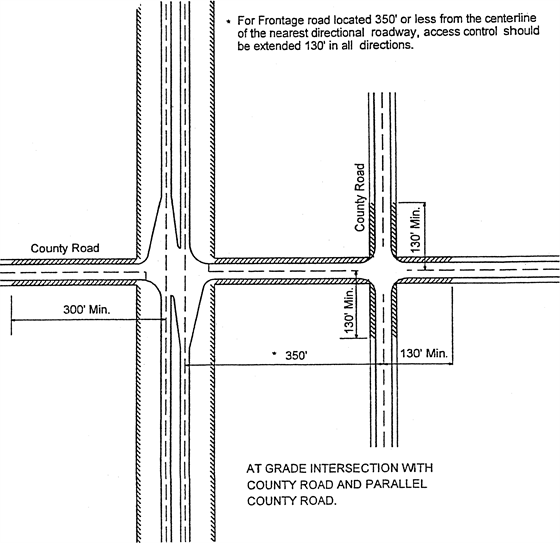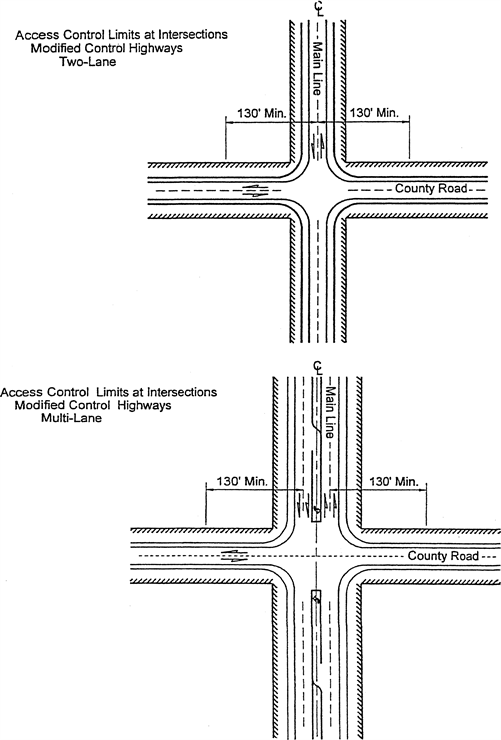PDFWAC 468-58-080
Guides for control of access on crossroads and interchange ramps.
(1) Fully controlled highways, including interstate.
(a) There shall be no connections to abutting property or local service or frontage roads within the full length of any "off" or "on" interchange ramp from a fully controlled limited access highway except as authorized under (e) of this subsection. Such ramp shall be considered to terminate at its intersection with the local road which undercrosses or overcrosses the limited access facility, provided that in urban areas "off" and "on" ramps may be terminated at local streets other than crossroads where necessary to service existing local traffic.
(b) There shall be no direct connections from the limited access facility in rural areas to local service or frontage roads except through interchanges.
(c) In both urban and rural areas access control on a fully controlled highway shall be established along the crossroad at an interchange for a minimum distance of three hundred feet beyond the centerline of the ramp or terminus of transition taper. If a frontage road or local road is located in a generally parallel position within three hundred fifty feet of a ramp, access control should be established along the crossroad and in addition for a minimum distance of one hundred thirty feet in all directions from the center of the intersection of the parallel road and crossroad.
(d) Full control of access should be provided along the crossroad from the centerline of a ramp or terminus of a transition taper for a minimum distance of three hundred feet. Upon determination by the department, full control of access may be provided for the first one hundred thirty feet from the centerline of the ramp or terminus of a transition taper and partial control or modified control of access may be provided for the remainder of the distance to the frontage road or local road for a total minimum distance for the two types of control of three hundred feet. Type A, B, C, D, E, and F road approaches, as defined hereafter under subsection (3) of this section, "general," may be permitted on that portion of the crossroad on which partial or modified control of access is established.
(e) Direct ramp access for transit buses may be allowed where solely determined by the department.
(2) Partially controlled highways.
(a) There shall be no connections to abutting property or local service or frontage roads within the full length of any "off" or "on" interchange ramp from a partially controlled limited access highway. Such ramp shall be considered to terminate at its intersection with the local road which undercrosses or overcrosses the limited access facility, provided that in urban areas "off" and "on" ramps may be terminated at local streets other than crossroads where necessary to service existing local traffic.
(b) In both urban and rural areas access control on a partially controlled highway shall be established along the crossroad at an interchange for a minimum distance of three hundred feet beyond the centerline of the ramp or terminus of transition taper. If a frontage road or local road is located in a generally parallel position within three hundred fifty feet of a ramp, access control should be established along the crossroad and in addition for a minimum distance of one hundred thirty feet in all directions from the center of the intersection of the parallel road and crossroad.
(c) Access control limits at the crossroads on a partially controlled highway should be established along the crossroad at a grade intersection for a minimum distance of three hundred feet from the centerline of the nearest directional roadway. If a parallel road is located within three hundred fifty feet of said grade intersection, access control should be established along the crossroad and in addition for a minimum distance of one hundred thirty feet in all directions from the center of the intersection of the parallel road and crossroad. Type D, E, and F approaches may be permitted closer than one hundred thirty feet from the center of the intersection only when they already exist and cannot reasonably be relocated.
(d) Access control limits at intersections on modified control highways should be established along the cross road for a minimum distance of one hundred thirty feet from the centerline of a two-lane highway or for a minimum of one hundred thirty feet from centerline of the nearest directional roadway of a four-lane highway. Type D, E, and F approaches should be allowed within this area only when no other reasonable alternative is available.
(3) General.
(a) Access control may be increased or decreased beyond or under the minimum requirements to fit local conditions if so determined by the department.
(b) Type A, B, C, D, E, and F approaches are defined as follows:
(i) Type A approach. Type A approach is an off and on approach in legal manner, not to exceed thirty feet in width, for sole purpose of serving a single family residence. It may be reserved by abutting owner for specified use at a point satisfactory to the state at or between designated highway stations.
(ii) Type B approach. Type B approach is an off and on approach in legal manner, not to exceed fifty feet in width, for use necessary to the normal operation of a farm, but not for retail marketing. It may be reserved by abutting owner for specified use at a point satisfactory to the state at or between designated highway stations.
(iii) Type C approach. Type C approach is an off and on approach in legal manner, for special purpose and width to be agreed upon. It may be specified at a point satisfactory to the state at or between designated highway stations.
(iv) Type D approach is an off and on approach in a legal manner not to exceed fifty feet in width for use necessary to the normal operation of a commercial establishment. It may be specified at a point satisfactory to the state at or between designated highway stations.
(v) Type E approach is a separated off and on approach in a legal manner, with each opening not exceeding thirty feet in width, for use necessary to the normal operations of a commercial establishment. It may be specified at a point satisfactory to the state at or between designated highway stations.
(vi) Type F approach is an off and on approach in a legal manner, not to exceed thirty feet in width, for the sole purpose of serving a wireless communication site. It may be specified at a point satisfactory to the state at or between designated highway stations.
The state shall only authorize such approach by the issuance of a nonassignable permit. The permit allows site access for the normal construction, operation and maintenance of the wireless communication site for the permit holder and its contractors but not its subtenants. If a sale or merger occurs that affects an existing wireless communication site, the new wireless communication provider will be authorized to utilize said approach upon the state's receipt of written notice of the sale or merger action. The wireless communication site access permit may be canceled upon written notice for reasons specified in the wireless communication site access permit general provisions. The permit will only be issued if it meets all state criteria, including, but not limited to, design and safety standards.
Only one wireless communication site access user per permit shall be allowed, but more than one permit may be issued for a single Type F approach.
Each permitted access user shall be required to pay to the state five hundred dollars annually in compensation for use of the state-owned access rights, at the time of the issuance of the permit and each year thereafter.
Since the state is the owner of the access, Type F approach permits shall not be issued pursuant to chapter 47.50 RCW and shall not confer a property right upon the permittee(s). An applicant for a Type F approach permit shall pay a nonrefundable access application fee when application is made in the amount of five hundred dollars for investigating, handling and granting the permit.
An application for wireless communication site access permit shall receive a response from the department of transportation within thirty working days from date of receipt of said application.
(c) Under no circumstances will a change in location or width of an approach be permitted unless approved by the secretary. Noncompliance or violation of these conditions will result in the immediate closure of the approach.
(d) Commercial approaches shall not be permitted within the limits of access control except where modified access control has been approved by the department.
(e) All access control shall be measured from the centerline of the ramps, crossroads or parallel roads or from the terminus of transition tapers. On multiple lane facilities measurement shall be from the centerline of the nearest directional roadway.
 |
 |
 |
 |
access control for typical roundabout |
 |
 |
access control limits at intersections |
[Statutory Authority: RCW 47.52.027 and 47.01.101. WSR 20-21-040, § 468-58-080, filed 10/13/20, effective 11/13/20. Statutory Authority: RCW 47.52.027. WSR 03-11-076, § 468-58-080, filed 5/20/03, effective 6/20/03. Statutory Authority: RCW 47.01.101(5). WSR 87-15-021 (Order 109), § 468-58-080, filed 7/8/87. Statutory Authority: RCW 47.52.020. WSR 79-08-061 (Order 34), § 468-58-080, filed 7/23/79. Statutory Authority: 1977 ex.s. c 151. WSR 79-01-033 (DOT Order 10 and Comm. Order 1, Resolution No. 13), § 468-58-080, filed 12/20/78. Formerly WAC 252-20-051.]